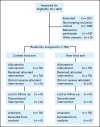Randomized comparison of cooked and noncooked diets in patients undergoing remission induction therapy for acute myeloid leukemia
- PMID: 18955453
- PMCID: PMC4879706
- DOI: 10.1200/JCO.2008.16.4681
Randomized comparison of cooked and noncooked diets in patients undergoing remission induction therapy for acute myeloid leukemia
Abstract
Purpose: A neutropenic diet is often used to prevent infection in patients with acute myeloid leukemia (AML). Although such a diet potentially entails inconvenience, its value is uncertain.
Patients and methods: One hundred fifty-three patients admitted to a high-efficiency particulate air-filtered room (protected environment [PE]) to receive induction therapy for newly diagnosed AML were randomly assigned to a diet containing no raw fruits or vegetables (cooked diet) or to a diet containing fresh fruit and fresh vegetables (raw diet). Stratification was based on the patients' early risk of mortality (ERM) score. All patients received antibacterial and antifungal prophylaxis and remained on study until they were discharged from the PE. The outcomes of principal interest were major infection (pneumonia, bacteremia, or fungemia) and death; if the true probability of either event was 20% on the cooked arm and 40% on the raw arm, then the probability that the cooked arm would be selected as superior was 83%.
Results: Seventy-eight patients were randomly assigned to the cooked arm, and 75 were assigned to the raw arm. The two groups were similar with respect to age, ERM, chemotherapy received, and days at risk. Twenty-nine percent of patients in the cooked group and 35% of patients in the raw group developed a major infection (P = .60). Time to major infection and survival time were similar in the two groups. Fever of unknown origin occurred in 51% of the cooked group and 36% of the raw group.
Conclusion: In patients treated in a PE, a neutropenic diet did not prevent major infection or death.
Figures



References
-
- Bodey GP, Buckley M, Sathe YS, et al: Quantitative relationship between circulating leukocytes and infection in patients with acute leukemia. Ann Intern Med 64:328-340, 1966 - PubMed
-
- Smith LH, Besser SG: Dietary restrictions for patients with neutropenia: A survey of institutional practices. Oncol Nurs Forum 27:515-520, 2000 - PubMed
-
- Wilson BJ: Dietary recommendations for neutropenic patients. Semin Oncol Nurs 18:44-49, 2002 - PubMed
Publication types
MeSH terms
Substances
LinkOut - more resources
Full Text Sources
Other Literature Sources
Medical

